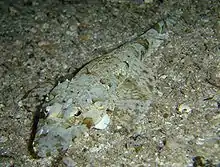De Beaufort's flathead
The Crocodilefish (Cymbacephalus beauforti), also known as De Beaufort's flathead or Giant flathead, is a member of the order Scorpaeniformes, which also includes the scorpionfishes and stonefishes.
| De Beaufort's flathead | |
|---|---|
 | |
| Scientific classification | |
| Kingdom: | |
| Phylum: | |
| Class: | |
| Order: | |
| Family: | |
| Genus: | |
| Species: | C. beauforti |
| Binomial name | |
| Cymbacephalus beauforti (L. W. Knapp, 1973) | |
Description
The Crocodilefish is a medium-sized fish which grows up to 50 cm (19.7 in), but the average size mostly observed is 35 cm (13.8 in).[1] The body is elongated and the head is particular because of its flat appearance like a duck bill. They have lappets at the rear of their globulous eyes, which help to break up the outline of the black iris and improve their camouflage. Juveniles begin black with few white spots and a white line behind the head. The adults have a body coloration which can vary in intensity according to the surrounding. The body is covered with a pattern like a mosaic of beige to brown spots or even greenish to grey separated by an interlacing of blue lines which ideally camouflaged them with their habitat.[2]
Distribution & Habitat
It is widely distributed throughout the tropical waters of the center of the Indo-West Pacific.[3]
Crocodilefish dwell in sandy patch and detritic zone where their camouflage is most effective, usually associated with reefs or mangroves in shallow water and protected areas. They are found in a range of depth from 2 to 30 m,
Alimentation
Crocodilefish are carnivorous, their diet is based on small fish and crustaceans.
Behaviour
They are benthic, solitary and predatory bottom-dwelling fish, using their camouflage to ambush their prey.
Eye lappet

References
- "Cymbacephalus beauforti, Crocodile fish : fisheries". Fishbase.org. 2012-07-03. Retrieved 2015-09-26.
- "Descriptions and articles about the Crocodile Fish (Cymbacephalus beauforti) - Encyclopedia of Life". Eol.org. 2009-07-24. Retrieved 2015-09-26.
- "Descriptions and articles about the Crocodile Fish (Cymbacephalus beauforti) - Encyclopedia of Life". Eol.org. 2009-07-24. Retrieved 2015-09-26.
External links
- {{EOL}} template missing ID and not present in Wikidata.
- MarineBio.org entry for Cymbacephalus beauforti (crocodilefish)
- Crocodilefish entry at Australian museum fish site
- Photos of several species of Crocodilefishes
- Marinespecies.org
- Photos of De Beaufort's flathead on Sealife Collection



-APiazza.JPG.webp)
-APiazza.JPG.webp)